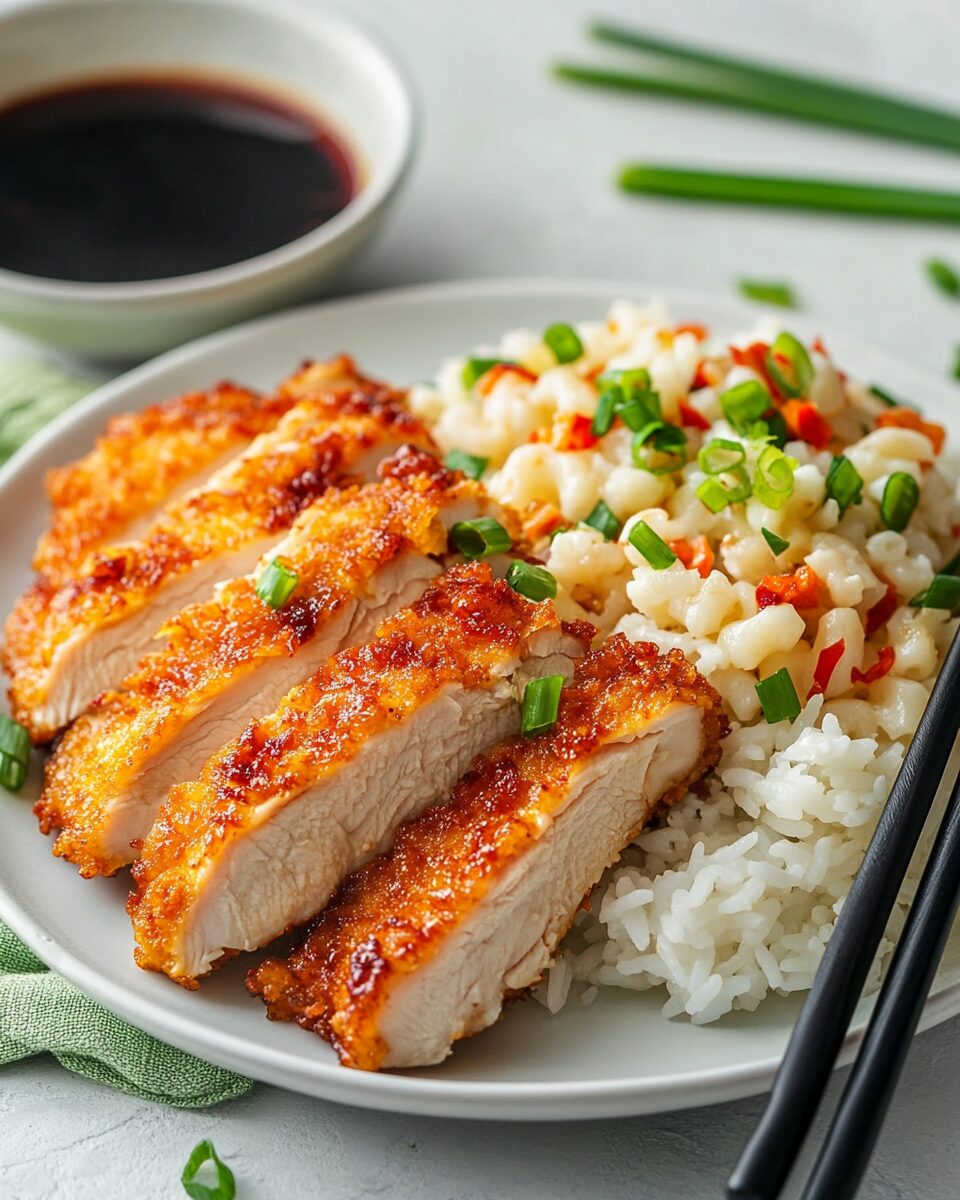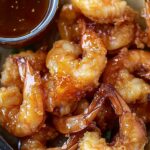This Hawaiian Style Chicken Katsu is a flavorful comfort food inspired by Hawaiian BBQ, featuring crispy chicken thighs served alongside mac salad, steamed white rice, and a rich tonkatsu sauce. It’s a meal that brings tropical flavors and satisfying textures to your table, perfect for dinner or a hearty lunch.
Full Recipe:
Ingredients
Mac Salad
- 16 ounces Elbow Macaroni, cooked and cooled
- 1/2 small Sweet Onion, grated
- 2 Carrots, grated
- 2 cups Mayonnaise
- 1 tablespoon Sugar
- 2 tablespoons Rice Wine Vinegar
- 1 teaspoon Kosher Salt and Ground Black Pepper
- 2 tablespoons Heavy Whipping Cream
Tonkatsu Sauce
- 2 tablespoons Ketchup
- 2 teaspoons Worcestershire Sauce
- 1/4 cup Oyster Sauce
- 1 tablespoon Brown Sugar
Chicken Katsu
- 4 Boneless Skinless Chicken Thighs
- 1/4 cup Water
- 3 Eggs, whisked
- 1/4 cup Cornstarch
- 1 teaspoon Kosher Salt
- 3 cups Panko Breadcrumbs
- Canola Oil, for frying
- Steamed White Rice, to serve
- Toasted Sesame Seeds and Green Onion, for garnish
Directions
Step 1: Prepare the Mac Salad
- Cook macaroni according to the package instructions, drain, and rinse with cold water.
- In a large bowl, whisk mayonnaise, sugar, vinegar, salt, and pepper.
- Add macaroni, grated onion, and carrots; toss to coat evenly.
- Cover and refrigerate for up to an hour. Stir in heavy whipping cream just before serving.
Step 2: Make the Tonkatsu Sauce
- Combine all sauce ingredients in a small saucepan.
- Heat until sugar dissolves, then transfer to a serving dish at room temperature.
Step 3: Prepare the Chicken Katsu
- Flatten chicken thighs to about 1/2 inch thickness using a meat mallet. Season with salt.
- In a shallow dish, whisk water, eggs, cornstarch, and salt. Place panko in another dish.
- Heat canola oil in a heavy pot to 350°F using an oil thermometer. Prepare a rack-lined pan for draining.
Step 4: Fry the Chicken
- Dip chicken thighs in the egg mixture, then coat with panko.
- Fry in hot oil for 6 minutes per side until golden brown. Transfer to the rack to drain.
Step 5: Serve
- Slice the chicken and serve with mac salad, steamed white rice, and tonkatsu sauce.
- Garnish with toasted sesame seeds and chopped green onion. Enjoy!
Estimated Nutritional Value (Per Serving)
- Calories: ~900-1000 kcal
- Protein: ~30-35 g
- Fat: ~50-60 g
- Saturated Fat: ~10-12 g
- Carbohydrates: ~90-100 g
- Sugars: ~10-12 g
- Dietary Fiber: ~2-4 g
- Sodium: ~1200-1400 mg
- Cholesterol: ~150-180 mg
Breakdown by Components
- Chicken Katsu (with Panko and Frying Oil):
- Calories: ~350-400 kcal
- Protein: ~20-25 g
- Fat: ~15-20 g
- Carbohydrates: ~20-30 g
- Mac Salad:
- Calories: ~300-350 kcal
- Protein: ~5-7 g
- Fat: ~25-30 g
- Carbohydrates: ~20-25 g
- Tonkatsu Sauce:
- Calories: ~40-60 kcal
- Carbohydrates: ~8-10 g
- Sodium: ~300-400 mg
- Steamed White Rice:
- Calories: ~200 kcal
- Protein: ~4-5 g
- Carbohydrates: ~45 g
The Origins of Chicken Katsu
Chicken Katsu traces its roots to the Japanese dish “tonkatsu,” which traditionally uses pork. Over time, the recipe adapted to various culinary traditions around the world, particularly in Hawaii, where local influences introduced new elements such as the inclusion of mac salad and a sweeter variation of tonkatsu sauce. Hawaii’s melting pot of cultures, blending Japanese, Filipino, Hawaiian, and American cuisines, turned this dish into a staple at local diners and plate lunch spots.
The Hawaiian adaptation of chicken katsu emphasizes casual dining and comforting flavors, aligning perfectly with the state’s laid-back vibe. It’s no wonder this dish is a favorite among locals and visitors alike.
The Alluring Combination of Flavors
One of the standout features of Hawaiian Style Chicken Katsu is the harmony of its components. Each element plays a role in creating a balanced and satisfying meal:
- Chicken Katsu: The star of the dish, chicken thighs are tenderized, seasoned, and coated with crispy panko breadcrumbs before being fried to golden perfection. The result is a crunchy exterior that contrasts beautifully with the juicy, flavorful meat inside.
- Mac Salad: Creamy and slightly tangy, mac salad provides a cooling counterpoint to the richness of the fried chicken. Grated carrots and onions add subtle sweetness and texture, while a hint of vinegar elevates the overall flavor profile.
- Tonkatsu Sauce: This sweet, tangy, and umami-rich sauce ties the dish together. Its complex flavor, achieved through a mix of ketchup, Worcestershire sauce, oyster sauce, and brown sugar, complements the fried chicken perfectly.
- Steamed Rice: The simplicity of plain white rice acts as a neutral base, soaking up the sauce and balancing the more robust flavors of the chicken and salad.
Why Chicken Thighs?
Unlike chicken breasts, thighs offer a higher fat content, which results in a juicier and more flavorful end product. This cut is less likely to dry out during frying, making it ideal for dishes like katsu. Additionally, chicken thighs are more forgiving during preparation, allowing for consistent results even for novice cooks.
The Role of Panko Breadcrumbs
Panko breadcrumbs, a Japanese innovation, are crucial for achieving the signature crunch of chicken katsu. Their light and airy texture creates a crisp coating without absorbing excessive oil during frying. This keeps the dish from feeling overly heavy while maintaining its satisfying crunch.
The Appeal of Hawaiian Mac Salad
Hawaiian mac salad stands apart from other variations of pasta salad due to its creamy consistency and uncomplicated seasoning. The addition of heavy whipping cream just before serving adds a touch of richness, while grated carrots and onions enhance its overall texture. It’s a side dish that pairs well with almost any main course, but it truly shines when served with chicken katsu.
Tonkatsu Sauce: The Flavorful Finishing Touch
Tonkatsu sauce is the crowning glory of this dish. Its sweet and savory profile complements the fried chicken without overpowering it. The blend of ingredients, including oyster sauce and brown sugar, delivers a depth of flavor that elevates the entire meal.
A Perfect Meal for Any Occasion
Hawaiian Style Chicken Katsu is versatile enough to serve on various occasions. It’s an excellent choice for a family dinner, a casual get-together with friends, or even a potluck party. The dish is easy to prepare in larger quantities, and its crowd-pleasing flavors make it a guaranteed hit.
Tips for Preparing Hawaiian Style Chicken Katsu
- Flatten the Chicken Evenly: Ensuring the chicken is an even thickness allows for uniform cooking, preventing overcooked edges and undercooked centers.
- Use a Thermometer for Frying: Maintaining the oil temperature at 350°F ensures that the chicken cooks evenly and achieves the perfect crispy texture.
- Don’t Skimp on the Sauce: A generous drizzle of tonkatsu sauce enhances the flavor of the chicken and ties the meal together.
- Prepare the Mac Salad Ahead: Allowing the mac salad to chill in the refrigerator helps the flavors meld together, resulting in a more cohesive taste.
- Choose Quality Ingredients: High-quality mayonnaise and fresh vegetables make a noticeable difference in the mac salad, while premium panko breadcrumbs ensure a superior crunch.
Health Considerations and Customizations
While Hawaiian Style Chicken Katsu is undeniably indulgent, there are ways to make it slightly healthier or adapt it to dietary preferences:
- Baking Instead of Frying: For a lighter version, bake the breaded chicken thighs in the oven. While you won’t achieve the same level of crispiness, the dish will still be delicious.
- Alternative Proteins: Substitute chicken with tofu, pork, or fish for variety or to cater to specific dietary needs.
- Gluten-Free Options: Use gluten-free panko and tamari in place of oyster sauce for a gluten-free meal.
- Lighter Mac Salad: Reduce the amount of mayonnaise or use a lighter version to lower the calorie content of the mac salad.
Cultural Significance and Popularity
In Hawaii, chicken katsu is more than just a meal—it’s part of a broader culinary tradition that reflects the island’s multicultural heritage. It’s commonly found in “plate lunches,” which typically include two scoops of rice, mac salad, and a protein. This format originated from plantation workers who brought their diverse cuisines to Hawaii, leading to the fusion of flavors and styles seen today.
Chicken katsu has since gained popularity beyond Hawaii, becoming a beloved dish in mainland U.S. restaurants and home kitchens. Its universal appeal lies in its satisfying taste and texture, as well as its adaptability to different flavor profiles.
Conclusion
Hawaiian Style Chicken Katsu is a culinary gem that encapsulates the flavors and spirit of Hawaiian cuisine. Its combination of crispy chicken, creamy mac salad, fluffy rice, and flavorful tonkatsu sauce makes it an unforgettable meal. Whether you’re recreating the dish for a special occasion or as part of your weekly meal rotation, it promises to transport you to the tropical shores of Hawaii with every bite. Its rich history and cultural significance add depth to its appeal, making it a dish worth savoring and sharing with loved ones.






